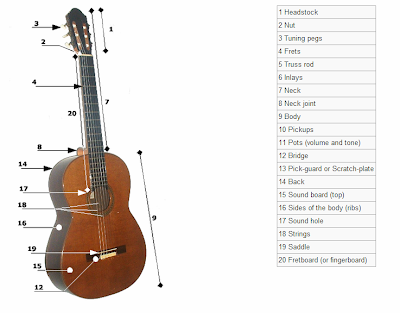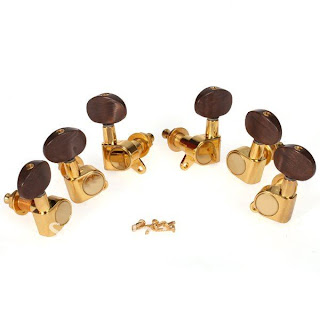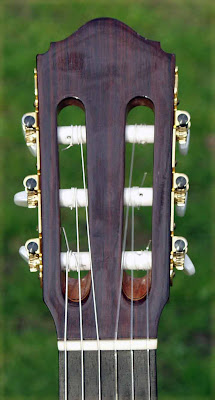(Playing Guitar For Beginners)
 |
| Playing Guitar For Beginners - Structure of a Guitar |
Body (9)
The body of a guitar consists of a treble or upper bout and a bass or lower bout. The waist is the narrow section that divides them. The body's one of the most important factors in determining the overall tone of a guitar. It provides the resonance that shapes the tonal qualities. It determines the volume of acoustic guitars and affects the sustain of electric guitars. The resonance is affected by the type of wood used, whether the body is made from layered woods or a single piece, whether it's hollow or solid and the shape and size
The woods listed below are used in the construction of both the acoustic and the electric guitar.
Tone wood
- Agathis is a type of pine that grows in East Asia. It's a plantation-wood used mainly for building cabinets. It's cheap and usually used in the construction of budget guitars. Its tone is similar to mahogany but more bland sounding with a less complex response.
- Alder is a light-weight wood that provides a clean balanced tonal response and good resonance. Its soft tight porous structure is similar to basswood but with a bolder hard grain pattern that adds to the stiffness and makes it more robust. Alder has a medium light tan color and provides a balanced tone across the frequency range with a slight upper mid-range producing a clean sound. Its resonance provides a good dynamic range.
- Ash offers two varieties for guitar construction and they differ in tone. Ash has an open grain pattern which requires a lot of lacquer to seal and this may result in less sustain than other woods. Ash's typically used in mid-range priced guitars.
- Northern hard ash is hard, heavy and dense. This gives it a bright tone and longer sustain.
- Swamp Ash (also known as Southern Soft Ash) comes from swamps in the Southern USA. Swamp Ash grows underwater which makes the wood light-weight and porous. Many Fender guitars from the 1950s were built with Swamp Ash. It has hard grain lines between its softer layers and a creamy light tan color with bold darker grain patterns. Its tonal qualities are a very nice balance of brightness, warmth and dynamic range with clear bell-like highs, slightly scooped mids and strong lows. Since it has good resonance across the whole frequency spectrum it can sound quite complex.
- Basswood's a light-weight (lighter than Alder) close-grained wood with a consistent and tight grain pattern. Its very soft with light colors that range from almost white to medium tan. Because it dents easily; it requires a hard finish (such as polyester) and good engineering to allow the screws and screw-holes to hold the parts. The installation of a tremolo system on such a softwood also means the body needs to be thicker to prevent cracking. Tonally, basswood has a warm soft tone which attenuates both the high and extreme low frequencies. It also creates a pronounced midrange fundamental frequency response and a reduced smoother high-end response. The tonal response compared with other softwoods such as ash and alder is less complex with a narrower dynamic range. Basswood doesn't excel in clean sounds though when coupled with distortion and overdriven amplifier produces a metal-lead sound much favoured by some rock guitarists. It's used in the construction of budget guitars and expensive guitars.
- Cedar became popular in the mid-twentieth century after master luthier Jose Ramirez III of Madrid pioneered the use of red cedar as a substitute for the increasingly scarce European spruce. It's now considered one of the world's premier tonewoods.
- Mahogany's a highly dense, heavy wood with a fine, open grain and large pores. The color is reddish brown. Tonally, it provides good low frequencies, a compressed mid-range and smooth sounding highs. Overall, its tone is mellow, soft and warm with a full and thick quality. Its density provides excellent sustain and also makes it less susceptible to dents and scratches. Its density and weight have led some manufacturers to experiment with a thinner body as seen in the Ibanez S series.
- Nato's another type of eastern mahogany though most current stock now comes from South America. It's also a commercial grade wood used in cabinet building. It has a bright tone with pronounced midrange but lacks in sensitivity and punch compared with other varieties of mahogany. Nato is used by the manufacturer B.C. Rich for their Assassin range.
- Maple's used for the backs and sides of more expensive acoustics like the J200 series by Gibson. Though not generally used as a table for flat-topped instruments; it's the wood of choice for arched top guitars, mandolins, and the violin family of instruments. Its usually white in color with tight pores and thin grain lines. There're two main types of American maple:
- Eastern Hard Maple is an excellent tonewood. As named, it's very hard and dense with a medium weight which makes it difficult to work and therefore it's usually reserved for necks. When used for the body, it provides a bright sound with very strong highs and upper mid-range but quieter bass frequencies. Overall, hard maple has a very long sustain. Eastern hard maple can exhibit a figure (grain pattern) called the "bird's eye" whose aesthetic appeal has led to it being used for guitar tops and backs usually bookmatched.
- Western Soft Maple is much lighter in weight than Hard Maple. It has a bright tone with good bite and attack though not as brittle as hard maple. Its tonal qualities produce singing highs with a tight low-end. This kind of maple is often seen with a figure called "flame" or "curl" and less commonly a figure called "quilt".
- Rosewood is used for the backs and sides of acoustics and also for fingerboards. It possesses an extremely high density making it very reflective acoustically. Its color is dark brown with reddish, purple or orange streaks running through it. There're many varieties of rosewood that're suitable for guitar construction.
- Poplar's a wood favoured by manufacturers who design budget guitars; especially by Danelectro as a center block with masonite used on the top and bottom. Due to the resurgence in popularity of the garage bands of the 1950s; guitars that use poplar are relatively expensive for such a budget wood. It's a closed grain wood with a greyish-green color and similar to alder in weight and tone.
- European Spruce is a premium tonewood used in the design of many stringed instruments including the violin, viola and lute. Increasing scarcity has resulted in the use of substitutes such as the North American species of spruce and red cedar.
- Walnut's a medium hard wood with a strong grain pattern. Its body has a constant density. It's harder, heavier and more dense than mahogany and therefore closer to maple. Tonally, it's warmer than maple with a solid low-end. The mid-range is relatively complex and the high-end is smooth and bright. Due to its density, it provides good sustain.
 |
| Playing Guitar For Beginners - Tone wood |
Some electric guitars have an extra top added to the body to blend the tonal qualities of different types of wood together. Maple with figuring is a popular top and produces a pronounced look and tone. Body tops are not used on acoustics since the layering of two pieces of wood for the table would inhibit the resonance and dull the tone.
Bridge (12)
The bridge is found on the lower bout of the body and its function is to allow the strings to sit at a relative height to the fretboard. Depending on the guitar, the strings may terminate at the bridge or just pass over it. On electric guitars the bridge can be raised or lowered; using two screws at either end of the bridge. This is discussed further in the Adjusting the Guitar section.
 |
| Playing Guitar For Beginners - Bridge |
The design of bridges varies greatly between different manufacturers and the above generic descriptions may not apply to some guitars. Regardless of the design the main purpose of all bridges is to maintain the strings at a relative height to the fretboard.
Fretboard (20) and Frets (4)
The fretboard is a piece of wood that's glued to the front of the neck. These're commonly made of rosewood though other hard woods, such as ebony for classical guitar fretboards, may also be used. Embedded in the fretboard are a number of metal frets usually numbering 20 to 24. Strings're pressed down behind a fret which changes the length of string that is free to vibrate therefore producing a different note. A simple demonstration is to be found on the 12th fret. On all guitars this's the fret that divides the string exactly in half and produces a note an octave higher than the open note. Any open string that maintains its original tension and is halved produces its octave; the same principle applies to all stringed instruments including the piano and violin.
There're a variety of fret designs. Jumbo frets are higher and wider than normal frets and require less fretboard contact to sound a clear note. Medium frets are closer to the board and must be firmly in contact with the fretboard to sound a clear note. Some guitarist prefer jumbo frets due to the ease with which you can bend strings and the faster play offered by less fretboard contact. As with many design elements of the guitar this's a subjective area that is more personal preference rather than advantage. Good technique is not dependent on fret size
The first fret is the one nearest the nut. Some manufacturers, notably Gibson, place a zero fret immediately after the nut; this maintains good intonation and action on flatter fretboards and wider necks. The strings sit on the zero fret therefore bringing the sound of the open string nearer to the quality of a fretted note.
Most fretboards have decorative inlays on the 3rd, 5th, 7th, 9th and 12th frets which serve as markers for the guitar positions. Fetboard inlays can be highly decorative or simple shapes. On more expensive guitars they are usually made of mother of pearl or abalone.
Headstock (Head) (1)
The headstock lies at the end of the guitar's neck. The purpose of the headstock is to support the tuners, which terminates the strings of the instrument. The tuners are attached to tuning pegs and this allows the guitarist to lower or raise the pitch of the string. A secondary purpose of the headstock is identification; many guitar manufacturers use a distinctive headstock shape, often in combination with a logo and model information.
The neck can be a single piece of wood or several pieces glued together and cut to shape. The fretboard is a seperate piece of wood that is attached to the neck. Necks can be glued to the body or bolted on. Set necks are usually found on acoustic guitars and many other instruments; including the violin, lute and cello. The bolt-on neck is a design feature of electric guitars. Most necks are wood though alternative materials, such as carbon fibre composites, have been used.
All strings pass through a nut at the headstock end of the fretboard. Its function is to maintain correct string spacing and alignment so that the strings feed into their respective tuning pegs. On acoustic guitars the nut and saddle are usually made of the same material. Electric guitars commonly use plastic or synthetic nuts though sometimes metal is used. As tremolo bars can cause tuning problems, guitars equipped with them usually have some manner of locking nut, where the strings are clamped down.
 |
| Playing Guitar For Beginners - Nut |
Pick Guard (13)
This's a flat piece of plastic attached to the body below the sound hole or surrounding the pickups. It prevents the body from being scratched by the pick. Some electric guitars have raised pick guards; so that when you strum through a chord your pick is directed out and away from the pots and strings. Pick guards sometimes need replacing due to wear or damage and in the case of expensive or rare guitars should be replaced by an experienced luthier. The pick guard is sometimes called a scratch plate.
Sound holes are found on all acoustics. Their primary purpose is to allow the air pressure to stay equalized so that the soundboard can vibrate. Most sound holes are round, but some guitars have violin style, f-shaped sound holes. Round sound holes usually have a decorated edge based on a geometrical design. On modern guitars these decorations are machine-made though some luthiers of expensive guitars use the traditional method of laying by hand small pieces of exotic woods.
Steel-string acoustics and electric guitars have a steel truss rod that runs through the neck under the fretboard. Strengthening the neck with a truss rod counteracts the tension exerted by the strings and allows the curvature of the neck to be adjusted. Classical guitars do not require a truss rod due to the low tensile strength and high elasticity of nylon strings. Some less expensive steel-string acoustics do not have a truss rod. Adjusting the truss rod can have a marked effect on the action, tuning and playability of a guitar and should be left to a luthier. Excessive adjustments to the truss rod can render a guitar unplayable and should be avoided.
Tuning Pegs (3)
Tuning pegs are used to raise and lower the pitch of the strings. Acoustics usually have two rows of three pegs; which when the guitar is held as normal presents one row at the top of the headstock and one row at the bottom. Electric guitars may have tuning pegs in a single row running along the top of the headstock (Fender Stratocaster) or use the the acoustic guitar layout.
 |
| Playing Guitar For Beginners - Tuning Pegs |















